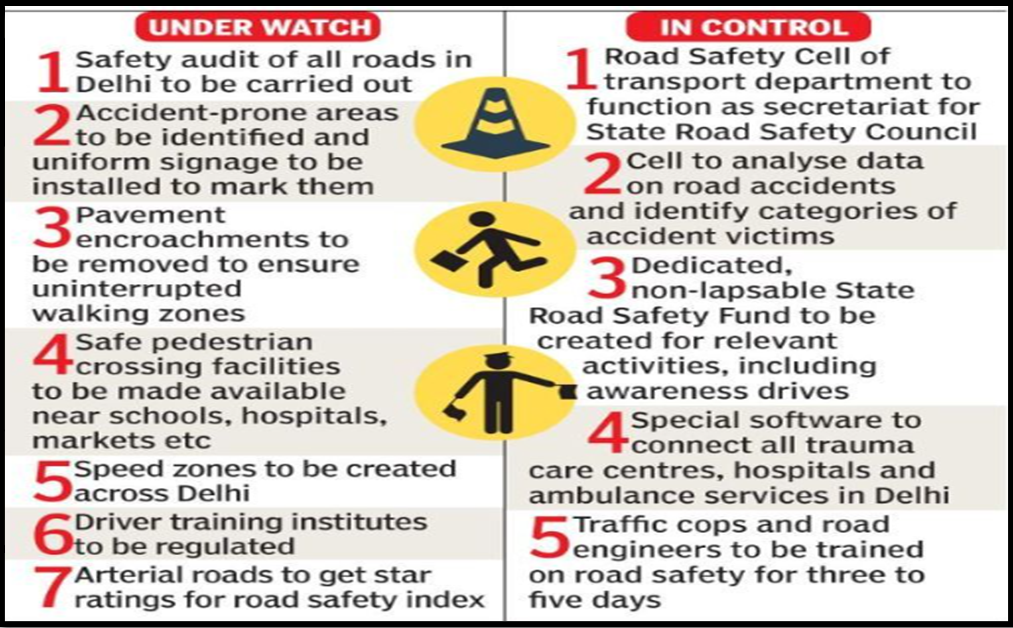“Road Safety and economic development go hand in hand”. In view of the above statement, discuss why it is important to address the issues of road safety and suggest remedial measures to improve the conditions of roads in India.
| Structure of Answer
Introduction · Briefly explain Relationship between Road safety and economic development Body · Mention Importance of Addressing Road Safety. · Mention Issues in Road Safety. · Mention Remedial Measures for Road Safety Improvement with examples Conclusion · Mention need for a comprehensive approach to ensure Road safety in India contributes to a more productive and economically vibrant society. |
Answer-
Road safety and economic development share a symbiotic relationship, with one significantly impacting the other. The World Health Organization underscores the economic toll of road accidents, estimating an average cost of 3% of GDP for developing countries. In India, where over 1.5 lakh lives are lost annually in road accidents, addressing road safety becomes imperative for sustainable economic growth.
Importance of Addressing Road Safety
- Human Capital Preservation: Road safety measures are imperative for preserving human capital. Fatalities and injuries result in a loss of skilled and productive individuals, impacting the workforce and economic productivity. For instance, if a breadwinner meets with a fatal accident, the economic repercussions on the family and community can be substantial.
- Healthcare Burden Reduction: Road accidents place a significant burden on the healthcare system. Emergency medical care, rehabilitation, and long-term healthcare for accident victims strain the healthcare infrastructure. Addressing road safety alleviates this burden, allowing resources to be allocated more efficiently.
Source: Times of India
- Productivity Enhancement: Safe roads contribute to increased productivity. Efficient transportation systems facilitate the smooth movement of goods and people, positively impacting trade, commerce, and overall economic activities. Conversely, frequent accidents and congested roads impede productivity.
- Insurance and Legal Costs: High rates of accidents lead to increased insurance premiums and legal costs for individuals and businesses. By prioritizing road safety, these financial burdens can be mitigated, fostering a more favorable economic environment.
- Tourism and Economic Growth: A country with a robust road safety infrastructure is likely to attract more tourists. Safe and well-maintained roads contribute to a positive image, encouraging tourism, which, in turn, stimulates economic growth through increased spending and job creation.
Issues in Road Safety
- Poor Infrastructure: Inadequate road infrastructure, characterized by poorly maintained roads, lack of signage, and inadequate lighting, contributes to accidents. Potholes and uneven surfaces pose significant risks.
- Non-Compliance with Safety Regulations: Non-compliance with safety measures such as seatbelt and helmet usage. Lack of enforcement leads to preventable casualties; for instance, speeding accounted for 70% of road crash deaths in India.
- Inadequate Emergency Response: Limited access to high-quality emergency care. Disparities in emergency response services affect the chances of survival and recovery after a road crash.
- Vulnerable Road Users: High proportion of vulnerable road users involved in accidents. Pedestrians, cyclists, and two-wheeler riders constitute nearly three-quarters of road crash victims in India.
- Outdated Vehicle Standards: The absence of stringent safety standards for vehicles, including outdated requirements and lax enforcement, puts lives at risk.
- Inadequate Public Transportation: Over-reliance on personal vehicles due to inadequate public transportation contributes to road congestion and increased accident.
Delhi Road Safety Model Source: Times of India
Remedial Measures for Road Safety Improvement
- Strengthening Road Infrastructure: Invest in high-quality road construction and maintenance. Improve signage, lighting, and road markings. Address issues like potholes and congestion through effective planning.
- Implementing Stricter Traffic Laws and Enforcement: Enforce stringent penalties for overspeeding, drunk driving, and other violations. Regularly update and adapt traffic laws to address emerging challenges.
- Promoting Road Safety Awareness: Conduct regular awareness campaigns through various media channels. Example: UN’s global campaign #MakeASafetyStatement involving international celebrities to promote responsible road behavior.
- Enhancing Vehicle Safety Standards: Mandate the use of safety features like airbags and ABS in all vehicles. Regularly update and enforce safety standards for vehicles.
- Investing in Public Transportation: Improve and expand public transportation networks to reduce reliance on private vehicles. Encourage the use of eco-friendly modes of transport.
- Legislative Reforms and Implementation: Implement and enforce comprehensive legislative reforms. Example: The Motor Vehicles (Amendment) Act, 2019, is a positive step towards stricter penalties and enhanced road safety.
- Global Best Practices Adoption: Learn from international success stories. Example: The Safe System Approach, as embraced in Sweden, focuses on multiple levels of intervention, including road design, vehicle safety, and user behavior.
The interconnectedness of road safety and economic development necessitates a comprehensive approach to address the challenges India faces. By prioritizing infrastructure development, implementing stringent traffic laws, fostering awareness, and investing in public transportation, India can significantly enhance road safety. These measures not only save lives but also contribute to a more productive and economically vibrant society.





